On Saturday, Aldo Lado passed away. He was the director of a handful of films in the early Seventies that left an indelible mark on the esoteric thriller genre, both Italian and beyond. For this occasion we celebrate his memory by republishing this article of ours on the essential work before him, The short night of the glass dolls, originally published in the first issue of the magazine «Massacro».
di Marco Maculotti
Article originally published on «Massacre» n.1, La Nuova Carne Edizioni, 2022
Exactly 50 years ago, on 28 October 1971, it was released in Italian cinemas The short night of the glass dolls, first work by the Rijeka director Aldo Lado, later also the author of Who saw her die? e The last train of the night. Taking advantage of this historic anniversary, we will try to demonstrate how the film in question viscerally influenced not only some films of the "satanic-conspiracy" genre by other Italian directors, but even Anglophone works much more considered by international critics, including Society by Brian Yuzna and, above all, Eyes Wide Shut, master Kubrick's swan song.
Power, whether economic or political,
Aldo Side
it is supported by the blood of the young.
I often find myself comparing, in terms of themes and narrative suggestions, American or English films, even very famous ones, with Italian productions released in theaters several years earlier, much less demanding in terms of budget and perhaps one hundredth as famous as the Anglophone ones, and yet unquestionably revolutionary and epochal even in the way, often rather homely, in which they were conceived and shot. This happens to me especially with thrillers and mysteries with horror undertones, of a psychological or esoteric nature: as regards this specific cinematographic genre, in fact, it is indisputable that films labeled as “spaghetti thriller” or “italian detective story” released between the mid-60s and the mid-70s, we literally dictated the rules of the genre, as they say.
Significant products are the first of Dario Argento, mostly L'uccello dalle piume di cristallo (1971) Four gray velvet flies (1972) and Deep red (1975). Not least are the turns in the genre in question of the factotum Mario bava, which preceded him by five years: we remember among many Six women for the killer (1964) Operation fear (1966) and Chain reaction (1971). It's also impossible not to mention Lucio fulci who, like Argento, before turning to horror, tried his hand at detective stories and Italian thrillers: they are essential A lizard in a woman's skin (1971) You don't torture a little duck (1972) and Seven notes in black (1977). They are also worth remembering Sergio Martino, Umberto Lenzi, Antonio Bido, Giuliano Carnimeo, Massimo Dallamano and obviously, The house with laughing windows (1976) of Pupi Avati.

And yet, among all the Italian films of this genre, the one that is probably the most sensational in terms of stylistic perfection, quality of narrative interlocking and extraordinary previews of much more acclaimed films, is The Night Court of the Glass Dolls, directed by Aldo Side and released in theaters in 1971 (Lado was also the director of two other captivating titles: Who saw her die?, 1972 e The last train of the night, 1975). Released in theaters exactly 50 years ago (precisely on 28 October 1971), attributable to the sub-strand of satanic conspiracy thriller — a handful of low-budget films among which the following ones should also be mentioned All the colors of the dark (S. Martino, 1972) e The perfume of the lady in black (F. Barilli, 1974), which generally draw inspiration from Polanski's masterpiece released a few years earlier (Rosemary's Baby, 1968) — The short night nevertheless he managed to develop an originality perhaps never seen again at such levels on our shores, capable of anticipating by several decades films such as Eyes Wide Shut (S. Kubrick, 1999), Society (B. Yuzna, 1989) and Memento (C. Nolan, 2001). Above all, the comparison is surprising - sometimes even scene by scene or character by character, as well as for general themes and suggestions - with Kubrick's swan song of thirty years later, as we will try to highlight in this short article.
The film was originally supposed to be titled Malastrana, name of a well-known neighborhood in Prague, the city where the film is set (although most of the scenes were filmed in Zagreb); at a later time the working title was changed to The short night of butterflies, in the wake of the Argentine thrillers (the famous "Animal Trilogy"), except that Duccio Tessari anticipated it very little with his A butterfly with bloody wings: Lado was thus forced to replace the "butterflies" of the provisional title with the now famous ones “Glass Dolls” of the definitive title. It's a shame because, as we will see, butterflies have a central symbolic importance in the narrative and imaginative economy of the film.

Since the novels of Gustav Meyrink - over all The Golem, released in 1915, the same year as the silent film of the same name directed by Henrik Galeen and Paul Wegener — Prague, in which Central European architecture and Jewish culture merge, is a perfect candidate to instill in the viewer eerie and sinister suggestions, but at the same time same also ethereal, which Lado searches for, similarly to the Roma de The sign of command (aired on Rai a few months earlier, during the summer of '71) and in Venice Nicolas Roeg (In Venice… a shocking red December!, 1973). For this reason, even if, as mentioned, the scenes filmed in the Czech capital are few, these are iconic both for the places filmed - the colorful streets of the ghetto, where according to legend a small old door opens directly onto the sheol, or the historic cemetery, where the graves seem to grow one on top of the other like infected teeth or mushrooms - which for the livid music of Ennio Morricone (orchestra conducted by Bruno Nicolai), which from the beginning invite the foreshadowing of enigmas and crimes.
In Prague the scenes were actually shot that the two protagonists, the American journalist Gregory Moore (Jean Sorel) and his young Czech lover Mira (Barbara Bach), spend together around the city: the only carefree moments, before the second she suddenly disappeared, during their first night together, after that evening Gregory had taken her to an exclusive party and had introduced her to high-ranking and influential people in the political and economic life of the nation; in other words, what is defined as “a toothless elite” («Gregory... where did you take me? This is the wax museum!","Among these men there are important figures from half of Europe... politicians, bankers, inverts willing to talk about it...»). A party that closely resembles the Ziegler party Eyes Wide Shut and which, similarly to it, gives way to the dark events that will follow.
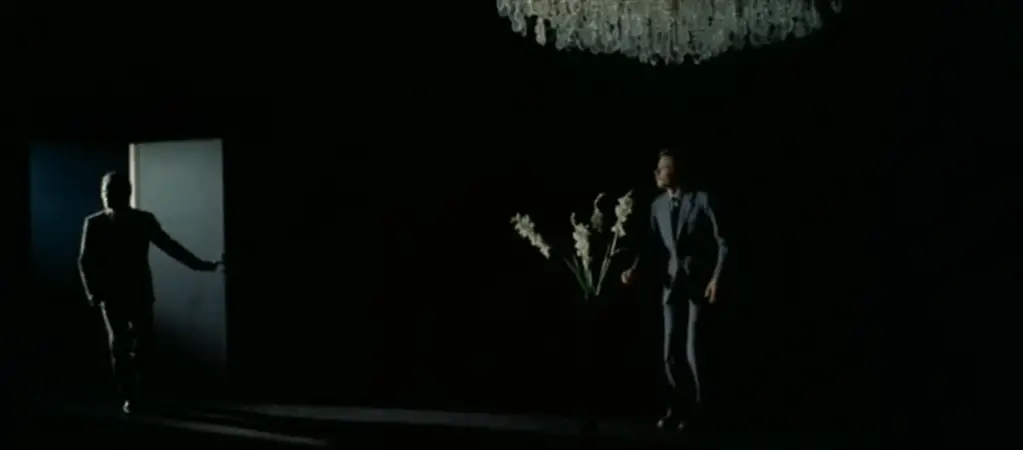
Like Alice (Nicole Kidman) in the film by Kubrick, who as soon as she is left alone by Bill (Tom Cruise) finds herself in the clutches of the old man on duty, immediately ready to suck her soul with grotesque jokes, the same happens to Mira, immediately surrounded by a group of drooling old men ( «He looks so compliant... Our young people are beautiful»). The hippie girl high on LSD who accompanies Jacques, Gregory's colleague played by Mario Adorf - as well as sensationally anticipating the iconic Uma Thurman in Kill Bill (1999) — finds a counterpart in Mandy, the prostitute who overdoses during the party at the Ziegler house. And also note that, if in Eyes Wide Shut Cruise plays a doctor, even at the party in Lado's film there is a cardiologist, Gregory's childhood friend, who later turns out to have contacts with the conspirators of the secret sect: in this he plays an almost identical role to the one that in Kubrick's film was attributed to Nick Nightingale, the pianist and former university friend of Bill's whom he met by chance with the Zieglers, who later took him straight to the hideout where the sect abandoned itself to orgiastic rituals.
The correspondences obviously don't stop here, starting from the importance in the dark plot of the secret sect of high-class people, dedicated to sexually exploiting young girls and sacrificing them in abject rites centered on sexual and vegetative energy: but we will have the opportunity to return to this. Also in Eyes Wide Shut central to the charade of events is the disappearance of one of the circuit girls, the tawny-haired prostitute who saves Bill's life by allowing him to leave the sect's villa once discovered: and the scene in which the latter arrives at the hospital to be able to seeing Amanda Curran's corpse is singularly reminiscent of that of Court night, in which Gregory is the one who rushes to the edge of a canal to recognize the now lifeless body of a young drowned woman, with identical red hair and a statuesque physique. And also pay attention to the scene in which Gregory, in the dark, tenderly watches Mira sleeping in her bed, before mysteriously disappearing; duplicated by Kubrick in the famous scene in which Bill, returning late at night, finds his wife Alice sleeping blissfully, with the Venetian mask on her pillow.
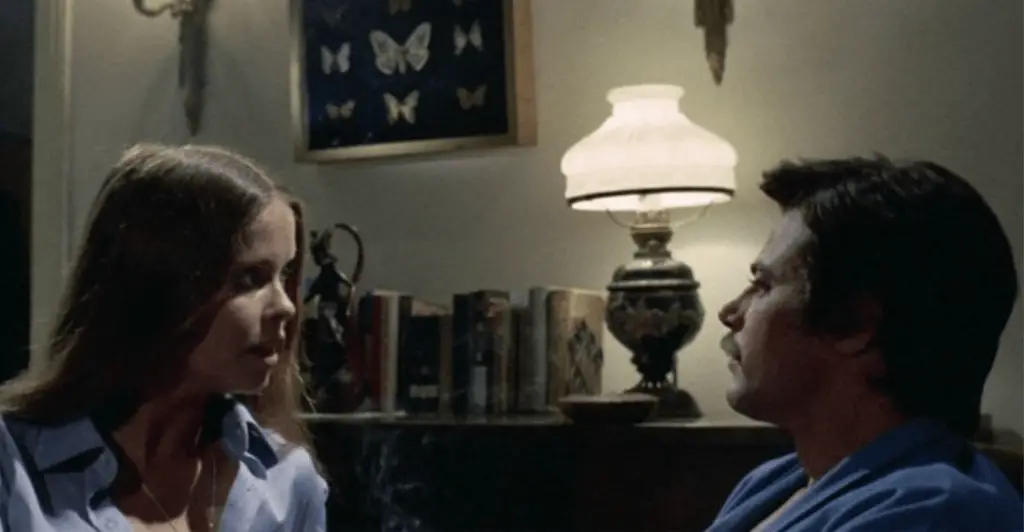
Mira's disappearance and her entanglement with the sect is symbolically connected, first by herself and later by an old informant member of the secret organization, with a particular kind of butterflies, perhaps also to be connected to the infamous Monarch Project. In fact, it is Mira herself who gives a small picture of it to Gregory, explaining to him that that type of lepidoptera «they belong to a strange species, they rise from the ground and jump, but they cannot fly, despite their beautiful colored wings... there are many of them here». Words that will then be echoed by the warnings of the "deep throat", which mentioning Gregory of mysterious Klub99 just before dying at his hands he whispers to him: «They-they don't fly… They don't let them fly away». A “butterfly room” is present in the Prague headquarters of Klub99. It is obviously relevant that the moth for the Greeks as for various other ancient populations was one imago of the soul: through occult orgies, in fact, the members of the confraternity psychically suck the vital (or vegetative) soul of Mira as well as the other young girls.
Investigating, before also being eliminated, Jacques discovers that «They have offices everywhere", in which "they consume too many flowers». In fact, it is no coincidence that the orgiastic and sacrificial rituals take place in a room where the participants literally wallow in bouquets of fresh flowers, which according to the dictates of sympathetic magic are used to act as medium, capturing the vegetative energy of the young victims to make it available to the "end users" («Was it useful to anyone?","To someone? To everyone! To all those who want to survive others, to be able to maintain power!»). In fact, as Doctor Karting (who ultimately turns out to be the "Grand Priest" of Klub99) states in an apparently innocuous scene of the film in which, by pricking a tomato with a pin, he demonstrates to some observers the suffering experienced by the vegetable, «The living world is a single unity, an indivisible whole... It is we men who place divisions, for our mere convenience").
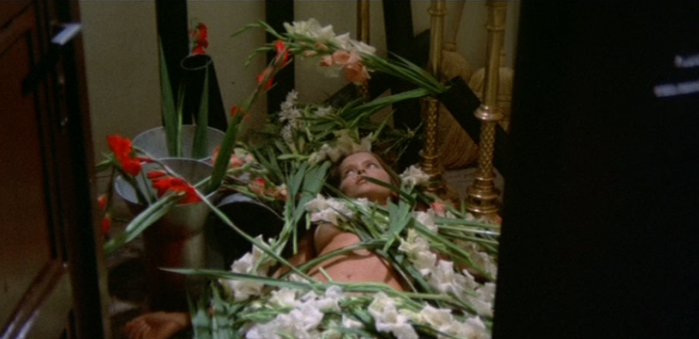
Gregory, finally entering the infamous Klub99 headquarters after closing time, finds the members engaged in the abominable ritual, and sees Mira at the center of the scene as sacrificial victim: a sequence that takes inspiration from the famous one of Rosemary's "magical insemination" and which anticipates the subsequent ones of Eyes Wide Shut and above all of Society of Yuzna, in addition to our local ones, equally indebted to Lado, by Sergio Martino in All the colors of the dark and by Francesco Barilli in The perfume of the lady in black, released in theaters in the years immediately following the Short night. (Also note how both in Klub99 and during the orgiastic evening in Kubrick's film the role of the piano is central). The invocations and magical formulas pronounced by the members of the sect also recall the aforementioned Polanski film, and the same can be said of the faces, made up in a gaudy and almost Fellini-like manner, of the members of the so-called “toothless elite”.
Similarities can also be noted in the modus operandi of the various sects, from Klub99 to those of Rosemary ed Eyes; but if in Polanski's film Guy Woodhouse, Rosemary's husband and Hollywood actor, obtains fame by virtue of the pact with the satanic brotherhood, in Short night Mira is apparently eliminated precisely because she did not want to compromise with the depravities of the sect: she would have died because «he rejected wealth and sex, the baits used all over the world, drugs that more than any other put thoughts and conscience to sleep... and now he sleeps"; "The rebels must be put to sleep, eliminated»). As in the two films mentioned here, anyone who tries to rebel against the dictates of the secret lodge is silenced, here even "put to sleep", a term to be understood here also in its esoteric, Gurdjieffian meaning, according to which the “Sleepers” they would be unaware human individuals, prisoners of their own condition un-awakened:
We need young people to keep us alive. They must become like us... They must think like us... Whoever refuses is put to sleep.
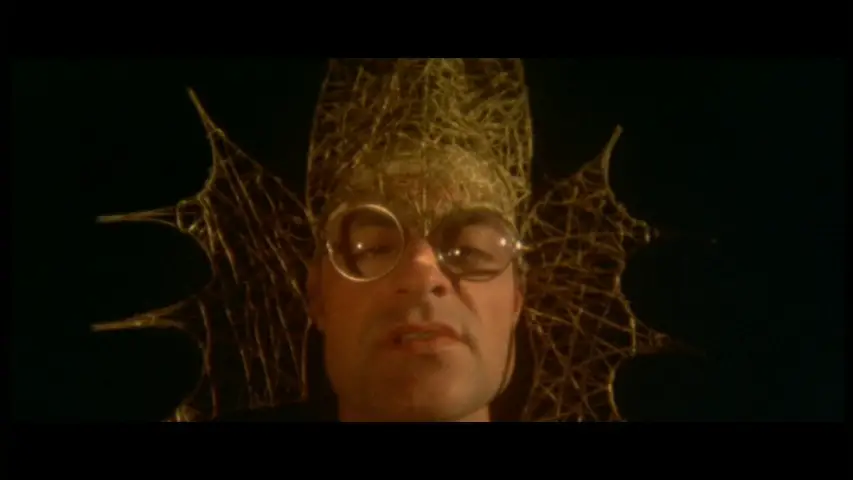
The esoteric and meta-political reading levels blend (and confuse) to perfection: as in Corrado Farina's film They have changed their face, released in Italian cinemas the same year as the film analyzed here, the political-financial ruling class is represented as a sect of vampires, whose ultimate aim is to "parasitize" the "healthy energies" of the nation's young people, maintaining their power over the masses through the soul-sucking of their often unaware victims, a theme that even anticipates John Carpenter's cult movie They Live (1988), in which the cryptic warning, written in large letters, resonates: «THEY LIVE. WE SLEEP». An element that is also found in the Short night by Lado, where the members of the infamous Klub99 themselves reveal to the protagonist Gregory, before "putting him to sleep" once and for all:
Nothing must change… We are the strength of the past. We will hold the ranks of the world as long as there are people willing to be killed, to shed their blood... Nothing must change... Our only enemy is thought, the awakening of consciences... Therefore we do not allow any rebellion... none!
Only thanks to this almost final scene we understand why, from the beginning of the film, Gregory appears in a state of apparent death, found in those conditions in the opening sequence of the film and taken to the morgue, because he is considered dead. In reality he is not yet, but he was precisely "asleep" by the members of the sect to silence him: it was Doctor Karting, knowledgeable of the vital mysteries of tomatoes and every other earthly form of consciousness, who “zombified” whispering occult formulas to him. It is for this reason that the entire narrative of events develops through continuous flashbacks, which are interspersed with scenes in which Gregory's "fake corpse" is examined: a meta-narrative device that will be exploited slavishly almost thirty years later late by the award-winning Christopher Nolan in the aforementioned Memento (2000)
In the truly final scene, which finally combines the two previously distinct chronological levels, the already "asleep" Gregory is definitively "eliminated" by Doctor Karting himself during a public autopsy, in which he pierces his heart with a scalpel: a fate fatal which finds a mocking prefiguration in a painting exhibited in Karting's home, representing in a stylized manner a human figure lying on a bed with a bleeding heart, and around him an indistinct plurality of standing figures.
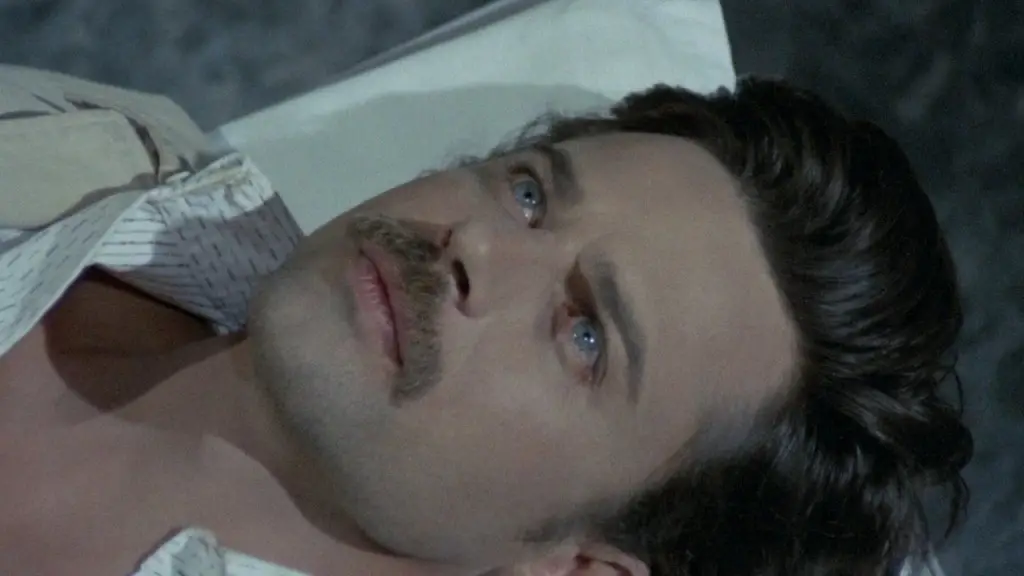

Excellent article (like all those signed by Maculotti); however “Operation Fear” by Mario Bava is pure gothic (Melissa's ghost causing suicides) not a thriller or a mystery….
Hi Christian, thank you for your appreciation.
It is true that "Operation Fear" has many characteristics of the Gothic genre (although I would not define it Gothic stricto sensu as, for example, by Bava himself, "The Mask of the Demon", "The Horrors of Nuremberg Castle" and perhaps also "The Red sign of madness”), however here I have included it en passant in the broader category of thriller simply as an example in Bava's filmography, being for me his most significant film in that category.
Best wishes,
MM